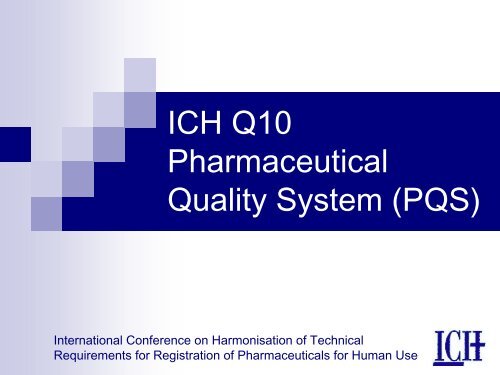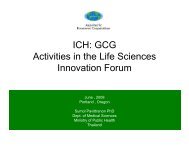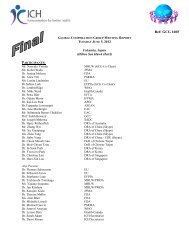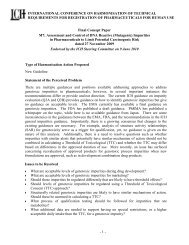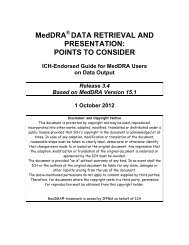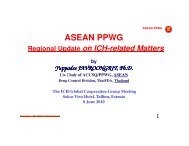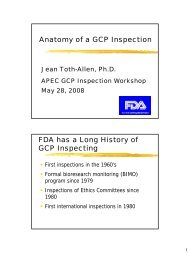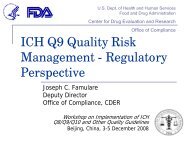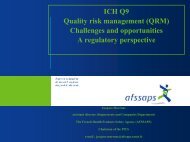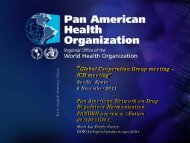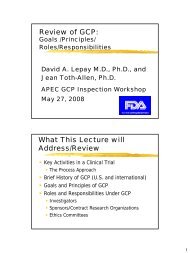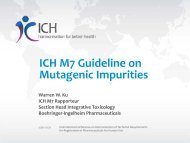ICH Q10 Pharmaceutical Quality System
ICH Q10 Pharmaceutical Quality System
ICH Q10 Pharmaceutical Quality System
You also want an ePaper? Increase the reach of your titles
YUMPU automatically turns print PDFs into web optimized ePapers that Google loves.
<strong>ICH</strong> <strong>Q10</strong><br />
<strong>Pharmaceutical</strong><br />
<strong>Quality</strong> <strong>System</strong> (PQS)<br />
International Conference on Harmonisation of Technical<br />
Requirements for Registration of <strong>Pharmaceutical</strong>s for Human Use
<strong>ICH</strong> <strong>Q10</strong> PQS Guideline<br />
• Background<br />
• Objectives<br />
• Scope<br />
• Content<br />
• Implementation<br />
• Conclusion<br />
2
Background<br />
• Vision<br />
Move from regulatory guidance to scientific guidance<br />
A harmonized pharmaceutical quality system applicable across<br />
the lifecycle of the product emphasizing an integrated approach<br />
to quality risk management and science<br />
• Companion guidelines<br />
high level<br />
more visionary<br />
less prescriptive<br />
flexible regulatory<br />
approaches<br />
‣ <strong>ICH</strong> Q8 <strong>Pharmaceutical</strong> Development<br />
‣ <strong>ICH</strong> Q9 <strong>Quality</strong> Risk Management<br />
‣ <strong>ICH</strong> <strong>Q10</strong> <strong>Pharmaceutical</strong> <strong>Quality</strong> <strong>System</strong><br />
3
Background (continued)<br />
• <strong>ICH</strong> Q8 Finalized November 2005<br />
<strong>ICH</strong> Q8(R1) (Step 2) November 2007<br />
• <strong>ICH</strong> Q9 Finalized November 2005<br />
• <strong>ICH</strong> <strong>Q10</strong> (Step 2) May 2007<br />
Public comments were received from the various Regions and<br />
consolidated<br />
Comments were considered and incorporated<br />
Major issues and revisions discussed<br />
Final resolution in in Portland<br />
• <strong>ICH</strong> <strong>Q10</strong> - Finalized June 2008<br />
4
Objectives of the Guideline<br />
To meet the objectives, <strong>ICH</strong> <strong>Q10</strong> augments Good<br />
Manufacturing Practices which are generally not<br />
repeated within the Guideline<br />
1. Achieve product realisation<br />
2. Establish and maintain a state of control<br />
3. Facilitate continual improvement<br />
5
Scope of Guideline<br />
• applies…throughout the product lifecycle<br />
(§3.1)<br />
<br />
<br />
<br />
<br />
<strong>Pharmaceutical</strong> Development<br />
Technology Transfer<br />
Commercial Manufacturing<br />
Product Discontinuation<br />
6
Scope of Guideline (continued)<br />
• …applies to the systems supporting the<br />
development and manufacture of<br />
pharmaceutical drug substances (i.e., API) and<br />
drug products, including biotechnology and biological<br />
products<br />
• …application is appropriate and proportionate to<br />
lifecycle stage<br />
• …includes…new and existing products.<br />
7
Content<br />
1. <strong>Pharmaceutical</strong> <strong>Quality</strong> <strong>System</strong><br />
2. Management Responsibility<br />
3. Continual Improvement of<br />
Process Performance and Product <strong>Quality</strong><br />
4. Continual Improvement of the<br />
<strong>Pharmaceutical</strong> <strong>Quality</strong> <strong>System</strong><br />
5. Glossary<br />
• Annex 1 - Potential Opportunities to Enhance Science and Risk Based<br />
Regulatory Approaches<br />
• Annex 2 - Diagram of the <strong>ICH</strong> <strong>Q10</strong> <strong>Pharmaceutical</strong> <strong>Quality</strong> <strong>System</strong> Model<br />
8
Content: §1 – PQS<br />
• Introduction / Scope / Objectives<br />
• Relationship of <strong>ICH</strong> <strong>Q10</strong> to<br />
Regional GMP Requirements, ISO Standards and <strong>ICH</strong> Q7<br />
Regulatory Approaches<br />
• Enablers<br />
Knowledge Management<br />
<strong>Quality</strong> Risk Management<br />
• Design and Content Considerations<br />
• <strong>Quality</strong> Manual<br />
9
Content: §2 – Management<br />
Responsibility<br />
• Management Commitment<br />
• <strong>Quality</strong> Policy, <strong>Quality</strong> Planning<br />
• Resource Management<br />
• Internal Communication<br />
• Management Review<br />
• Management of<br />
<br />
<br />
Outsourced Activities and Purchased Materials<br />
Change in Product Ownership<br />
10
Content: §3 – Continual Improvement<br />
of Process Performance<br />
& Product <strong>Quality</strong><br />
Two major sections:<br />
• §3.1 Lifecycle Stage Goals – 4 stages<br />
• §3.2 PQS Elements – 4 elements<br />
11
Content: §3.1 Lifecycle Stage Goals<br />
• 1 <strong>Pharmaceutical</strong> Development<br />
design product and process to consistently deliver the<br />
intended performance and meet the needs of [parties]<br />
exploratory and clinical development studies are inputs<br />
• 2 Technology Transfer<br />
transfer product/process knowledge between<br />
development and manufacturing, and within or between<br />
sites<br />
12
Content: §3.1 Lifecycle Stage Goals<br />
(continued)<br />
• 3 Commercial Manufacturing<br />
achieving product realisation, establishing and<br />
maintaining a state of control, and facilitating<br />
continual improvement<br />
• 4 Product Discontinuation<br />
manage the terminal stage of the product lifecycle<br />
effectively<br />
13
Content: §3.2 PQS Elements<br />
1 Process Performance and Product <strong>Quality</strong> Monitoring<br />
<strong>System</strong><br />
• A monitoring system to ensure a state of control is maintained<br />
• The process performance and product quality monitoring system<br />
should:<br />
<br />
<br />
<br />
<br />
<br />
<br />
Use quality risk management (<strong>ICH</strong> Q9 for example) to establish the control<br />
strategy.<br />
Provide the tools for measurement and analysis of parameters and attributes<br />
Analyse parameters and attributes<br />
Identify sources of variation for potential continual improvement activities<br />
Include feedback on product quality from both internal and external sources<br />
Provide knowledge to enhance process understanding, enrich the design space<br />
(where established), and enable innovative approaches to process validation.<br />
14
Content: §3.2 PQS Elements (continued)<br />
2 Corrective Action and Preventive Action (CAPA) <strong>System</strong><br />
• A system for implementing<br />
corrective actions resulting from the investigation of complaints, product<br />
rejections, non-conformances, recalls, deviations, audits, regulatory<br />
inspections and findings<br />
preventive actions resulting from trends from process performance and<br />
product quality monitoring<br />
• CAPA methodology should result in product and process<br />
improvements and enhanced product and process understanding<br />
15
Content: §3.2 PQS Elements (continued)<br />
3 Change Management <strong>System</strong><br />
• A change management system ensures continual improvement is<br />
undertaken in a timely and effective manner.<br />
<br />
It should provide a high degree of assurance there are no unintended<br />
consequences of the change<br />
• Change Management should, as appropriate for the lifecycle stage:<br />
<br />
<br />
<br />
<br />
Use <strong>Quality</strong> risk management (Q9) to evaluate proposed changes<br />
Evaluate proposed changes relative to the marketing authorisation and need for<br />
a change to the regulatory filing<br />
Evaluate proposed changes using expert teams<br />
Evaluate the change after implementation to confirm the change objectives were<br />
achieved and that there was no deleterious impact on product quality.<br />
16
Content: §3.2 PQS Elements (continued)<br />
4 Management Review of Process Performance and<br />
Product <strong>Quality</strong><br />
• Management reviews provide assurance that process performance<br />
and product quality are managed over the lifecycle<br />
• Includes data from a wide range of external and internal sources<br />
• Results in appropriate actions, such as:<br />
<br />
<br />
<br />
Improvements to manufacturing processes and products<br />
Training and/or realignment of resources<br />
Capture and dissemination of knowledge<br />
17
Content: §4 – Continual<br />
Improvement of the PQS<br />
• Management Review of the<br />
<strong>Pharmaceutical</strong> <strong>Quality</strong> <strong>System</strong><br />
• Monitoring of Internal and External Factors<br />
Impacting the <strong>Pharmaceutical</strong> <strong>Quality</strong><br />
<strong>System</strong><br />
• Outcomes of Management Review and<br />
Monitoring<br />
18
Content: ..in addition<br />
• §5 – Glossary<br />
• Annex 1 – Potential Opportunities to<br />
Enhance Science and Risk Based<br />
Regulatory Approaches<br />
• Annex 2 – Diagram of the <strong>ICH</strong> <strong>Q10</strong><br />
<strong>Pharmaceutical</strong> <strong>Quality</strong> <strong>System</strong> Model<br />
19
<strong>ICH</strong> <strong>Q10</strong> PQS<br />
<strong>Pharmaceutical</strong><br />
Development<br />
Technology<br />
Transfer<br />
Commercial<br />
Manufacturing<br />
Product<br />
Discontinuation<br />
Investigational products<br />
GMP<br />
Management Responsibilities<br />
Process Performance & Product <strong>Quality</strong> Monitoring <strong>System</strong><br />
PQS Corrective Action / Preventive Action (CA/PA) <strong>System</strong><br />
elements<br />
Change Management <strong>System</strong><br />
Management Review<br />
Enablers<br />
Knowledge Management<br />
<strong>Quality</strong> Risk Management<br />
20
Integration of Q8, Q9, & <strong>Q10</strong><br />
• An integrated set of guidelines:<br />
Q8 <strong>Pharmaceutical</strong> Development<br />
Q9 <strong>Quality</strong> Risk Management<br />
<strong>Q10</strong> <strong>Pharmaceutical</strong> <strong>Quality</strong> <strong>System</strong>s<br />
• Q8, 9, & 10:<br />
<strong>Quality</strong> by Design, Risk Management, and PQS<br />
provide greater product assurance of quality<br />
21
Integration of Q8, Q9, & <strong>Q10</strong> (continued)<br />
•Q8 & 10:<br />
Processes for pharmaceutical<br />
development are key linkages to<br />
product realization within the PQS.<br />
Q8 provides for robust development<br />
and understanding that serves as<br />
the basis for continual improvement.<br />
Manufacturers with a robust PQS<br />
and appropriate process knowledge<br />
can implement many types of<br />
improvements.<br />
•Q9 & 10:<br />
The PQS should encourage<br />
and facilitate the use of<br />
<strong>Quality</strong> Risk Management<br />
approaches throughout the<br />
system.<br />
The design and application of<br />
processes within the PQS<br />
should be based on<br />
appropriate risk management<br />
principles and methods<br />
22
Implementation of <strong>Q10</strong><br />
• Annex 1 - Potential Opportunities to<br />
Enhance Science and Risk Based<br />
Regulatory Approaches<br />
Annex reflects potential opportunities to<br />
enhance regulatory approaches.<br />
The actual regulatory process will be<br />
determined by region.<br />
23
Annex 1 - Potential Opportunities<br />
Scenario<br />
Potential Opportunity<br />
1. Comply with GMPs Compliance – status quo<br />
2. Demonstrate effective PQS,<br />
including effective use of<br />
quality risk management<br />
principle<br />
3. Demonstrate product and process<br />
understanding, including<br />
effective use of quality risk<br />
management principles<br />
Opportunity to increase use of risk<br />
based approaches for regulatory<br />
inspections<br />
Opportunity to<br />
•facilitate science based pharmaceutical<br />
quality assessment<br />
•enable innovative approaches to<br />
process validation<br />
•establish real-time release mechanisms<br />
24
Annex 1 - Potential Opportunities<br />
Scenario<br />
4. Demonstrate effective<br />
pharmaceutical quality<br />
system and product and<br />
process understanding,<br />
including the use of<br />
quality risk management<br />
principles<br />
Potential Opportunity<br />
Opportunity to:<br />
• increase use of risk based approaches for<br />
regulatory inspections<br />
• facilitate science based pharmaceutical quality<br />
assessment<br />
• optimise science and risk based post-approval<br />
change processes to maximise benefits from<br />
innovation and continual improvement<br />
• enable innovative approaches to process<br />
validation<br />
• establish real-time release mechanisms<br />
25
Conclusion<br />
• <strong>ICH</strong> <strong>Q10</strong> is not intended to create any new expectations<br />
beyond current regulatory requirements. Consequently,<br />
the content of <strong>ICH</strong> <strong>Q10</strong> that is additional to current<br />
regional GMP requirements is optional.<br />
• The elements of <strong>ICH</strong> <strong>Q10</strong> should be applied in a manner<br />
that is appropriate and proportionate to each of the<br />
product lifecycle stages, recognising the differences<br />
among, and the different goals of each stage<br />
26


